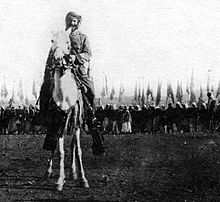Battle of al-Mazraa
| Battle of al-Mazraa | |||||||
|---|---|---|---|---|---|---|---|
| Part of The Great Syrian Revolt | |||||||
 Sultan Pasha al-Atrash's return from exile, 1937 | |||||||
| |||||||
| Belligerents | |||||||
|
| Druze and Bedouin rebels | ||||||
| Commanders and leaders | |||||||
|
|
Sultan Pasha al-Atrash | ||||||
| Strength | |||||||
| 3,500 French and colonial troops (infantry, cavalry, armored cars, artillery) | 500 (cavalry) | ||||||
| Casualties and losses | |||||||
| 601 fatalities, 428 wounded | |||||||
The Battle of al-Mazra'a (
Prelude
In the beginning years, the Druze under the leadership of the
After the high commissioner, General Maurice Sarrail arrested and banished three Druze sheikhs to Palmyra on 11 July 1925, Sultan al-Atrash launched a rebellion which became known as the Great Syrian Revolt. After shooting down a French military aircraft, al-Atrash's forces destroyed a French Army reinforcement column, killing 111 soldiers out of 174,[6] in the Battle of al-Kafr on 22 July.[7]
Battle
Following the French defeat at
The French reached the agricultural town of al-Mazraa at the base of Jabal al-Druze after a march of 25 kilometers on 2 August. The terrain consisted of largely flat open areas with little vegetation. Movement in al-Mazraa could be easily detected from the slopes of Jabal al-Druze and al-Atrash was able to plainly view the French force when they stopped in the town.[8] Al-Atrash's cavalry, which consisted of roughly 500 Druze and Bedouin fighters, subsequently assaulted the French column, inflicting moderate casualties before being routed.[8]
Afterward, in the early hours of 3 August, al-Atrash's men launched a second attack on a supporting ammunition convoy, forcing it to retreat to Izra'. Consequently, and because of the hot and dry weather conditions, General Michaud also decided to withdraw to Izra'. Seeing the French column in full retreat, al-Atrash's forces assaulted Michaud's troops, completely routing the French advance on al-Suwayda. The French force's second-in-command Major Jean Aujac and his 42nd Battalion of
Survivors of the Malagasy rearguard fled while Major Aujac committed suicide on the battlefield by shooting himself.[8] At the end of the battle, 1,029 French, Senegalese and Malagasy soldiers and their Syrian auxiliaries had been killed or wounded,[9] while much of the remainder of the French-led force had been captured or deserted .[7]
Aftermath

The battle at al-Mazraa ended in a victory for Sultan al-Atrash, and his men were able to capture 2,000 rifles with ammunition and supplies, several machine guns and an
French authority over most of Jabal al-Druze was lost as a result of the battle, although a French garrison remained in control of al-Suwayda for over a month.[7] Short of supplies, the French withdrew from al-Suwayda by 24 September, leaving much of the town destroyed.[12] Following his defeat, which had caused great embarrassment to the Mandate government,[1] General Michaud was recalled to France in disgrace.[7][13] He was replaced by General Maurice Gamelin.[13]
News of the victory of Sultan al-Atrash reached Damascus shortly after the battle's end, inspiring Syrian nationalists in the country's capital and the countryside to join the Druze in revolt. During the next few months, most of the regions under French rule in Syria rose in rebellion.
References
- ^ a b Betts, 2010, p. 139.
- ^ Betts, 2010, pp. 85-86.
- ^ Betts, p. 85.
- ^ Betts, 2010, p. 86.
- ^ Betts, 2010, p. 87
- ^ Charles Lavauzelle, page 320 "Les Troupes de Marine 1622-1984" I.S,B.N. 2-7025-0142-7
- ^ a b c d e f g Betts, 2010, p. 88.
- ^ a b c d e f g Provence, 2005, p. 63.
- ^ Charles Lavauzelle, page 322 "Les Troupes de Marine 1622-1984" I.S,B.N. 2-7025-0142-7
- ^ Provence, 2005, pp. 63-64.
- ^ Provence, 2005, p. 75.
- ^ Jacques, 2007, p. 980.
- ^ a b Provence, 2005, p. 91.
- ^ Provence, 2005, p. 64.
Bibliography
- Betts, Robert Brenton (2010). The Druze. Yale University Press. ISBN 978-0300048100.
- Jacques, Tony (2007). Dictionary of Battles and Sieges: P-Z. Greenwood Publishing Group. ISBN 978-0313335396.
- Provence, Michael (2005). The Great Syrian Revolt and the Rise of Arab Nationalism. University of Texas Press. ISBN 9780292706804.

